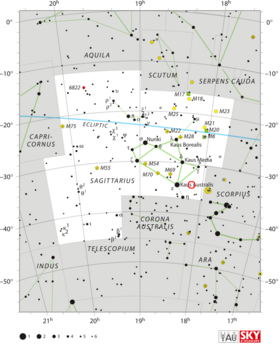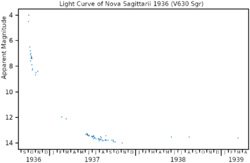Astronomy:V630 Sagittarii
| Observation data Equinox J2000.0]] (ICRS) | |
|---|---|
| Constellation | Sagittarius |
| Right ascension | 18h 08m 48.25s |
| Declination | −34° 20′ 21.4″ |
| Apparent magnitude (V) | 4.5 - 21.3[1] |
| Characteristics | |
| Variable type | Nova,[2] VY Scl, and eclipsing[1] |
| Astrometry | |
| Distance | 2000[3] pc |
| Other designations | |
| Database references | |
| SIMBAD | data |
V630 Sagittarii (Nova Sagittarii 1936) was a nova visible to the naked eye in 1936. It was discovered on 3 October 1936 by Shigeki Okabayashi of Kobe, Japan when it had an apparent magnitude of 4.5.[4]
There is disagreement within the astronomical literature about what this nova's peak brightness was. Both Warner[4] and Downes et al.[6] report a peak brightness of magnitude 1.6 but Duerbeck reports 4.0[3] in rough agreement with the Harrison and Gehrz value of 4.5.[7] The AAVSO database contains no magnitude estimates for this star brighter than 6.5 (on 8 October 1936), indicating that whatever the peak brightness was, the star was barely visible to the naked eye just five days after its discovery. Its light curve shows it to be one of the most rapidly fading novae on record.[5]
Duerbeck estimated that the star's absolute magnitude at peak brightness was −9.3.[3] Diaz and Steiner list it as a possible magnetic nova, due to its short decay time (< 20 days) and large amplitude outburst.[8]
All classical novae are binary systems, with a donor star losing mass onto the surface of a white dwarf. Mróz et al. report that in the case of V630 Sagittarii, the donor star is a main sequence star.[9] Since all classical novae are very close binary systems, they are frequently also eclipsing binaries. Woudt and Warner detected these eclipses, which are 0.4 to 0.6 magnitudes deep, allowing them to derive an orbital period of 2.831 hours.[10] Mróz et al. report the presence of superhumps.[9]
References
- ↑ 1.0 1.1 "V630 Sgr". American Association of Variable Star Observers. https://www.aavso.org/vsx/index.php?view=detail.top&oid=28330.
- ↑ Warner, B. (1 July 1987). "Absolute magnitudes of cataclysmic variables". Monthly Notices of the Royal Astronomical Society 227: 23–73. doi:10.1093/mnras/227.1.23. Bibcode: 1987MNRAS.227...23W.
- ↑ 3.0 3.1 3.2 Duerbeck, H.W. (April 1981). "Light curve types, absolute magnitudes, and physical properties of galactic novae". Publications of the Astronomical Society of the Pacific 93 (552): 165. doi:10.1086/130799. Bibcode: 1981PASP...93..165D.
- ↑ 4.0 4.1 4.2 Warner, B. (February 2006). "Where have all the novae gone?". Astronomy & Geophysics 47 (1): 29–32. doi:10.1111/j.1468-4004.2006.47129.x. Bibcode: 2006A&G....47a..29W.
- ↑ 5.0 5.1 Gaposchkin, S. (1955). "Notes and observations: Nova Sagittarii 1936". Astronomical Journal 60: 454. doi:10.1086/107259. Bibcode: 1955AJ.....60..454G.
- ↑ Downes, Ronald; Webbink, Ronald F.; Shara, Michael M. (April 1997). "A Catalog and Atlas of Cataclysmic Variables-Second Edition". Publications of the Astronomical Society of the Pacific 109 (734): 345–440. doi:10.1086/133900. Bibcode: 1997PASP..109..345D.
- ↑ Harrison, T.E.; Gehrz, R.D. (February 1991). "IRAS observations of classical novae. II - Modeling the detections". Astronomical Journal 101: 587–599. doi:10.1086/115708. Bibcode: 1991AJ....101..587H.
- ↑ Diaz, M.P.; Steiner, J.E. (September 1991). "UBVRI photometry of CP Puppis - A magnetic nova?". Publications of the Astronomical Society of the Pacific 103: 964–968. doi:10.1086/132913. Bibcode: 1991PASP..103..964D.
- ↑ 9.0 9.1 Mróz, P.; Udalski, A.; Poleski, R.; Soszyński, I.; Szymański, M.K.; Pietrzyński, G.; Wyrzykowski, L.; Ulaczyk, K. et al. (August 2015). "Ogle Atlas of Classical Novae. I. Galactic Bulge Objects". The Astrophysical Journal Supplement Series 219 (2): 26. doi:10.1088/0067-0049/219/2/26.
- ↑ Woudt, Patrick A.; Warner, Brian (November 2001). "High-speed photometry of faint cataclysmic variables - I. V359 Cen, XZ Eri, HY Lup, V351 Pup, V630 Sgr, YY Tel, CQ Vel and CE-315". Monthly Notices of the Royal Astronomical Society 328 (1): 159–166. doi:10.1046/j.1365-8711.2001.04857.x.
 |



